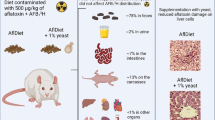Abstract
Excretion of radioactivity by mink (Mustela vison) during 7 days after intraperitoneal injection of two different amounts of aflatoxin B1 was studied. Male mink that received a single dose of 25 μg aflatoxin B1/kg body weight excreted an average of 89.5% of administered radioactivity (56.8% via feces, 32.7% via urine); whereas female mink excreted an average of 85% (63.6% via feces, 21.4% via urine) of administered radioactivity during the 7-day period. Male and female mink given 150 μg aflatoxin B1/kg body weight excreted an average of 76.9–80.1% of administered radioactivity during the 7 days that followed treatment with toxin. These mink excreted somewhat more of the administered radioactivity in their urine than did the mink that received the lower dose of aflatoxin (37.2 vs. 32.7% for males and 32.7 vs. 21.4% for females). Regardless of sex and dosage of toxin, most of the radioactivity ultimately excreted either through feces or urine appeared in the first 24 h after toxin was administered to mink.
Zusammenfassung
An Nerzen (Mustela vison) wurde die Ausscheidung von Radioaktivität während 7 Tagen nach intraperitonealer Injektion zweier verschieden hoher Dosen von markiertem Aflatoxin B1 untersucht. Männliche Tiere, die eine einmalige Dosis von 25 μg Aflatoxin B1 pro kg Körpergewicht erhielten, schieden im Durchschnitt 89,5% der verabreichten Radioaktivität aus (56,8% im Kot, 32,7% im Urin), während weibliche Tiere in der Zeitspanne von sieben Tagen im Durchschnitt 85% der verabreichten Radioaktivität ausschieden (63,6% im Kot, 21,4% im Urin). Männliche und weibliche Tiere, die 150 μg Aflatoxin B1 pro kg Körpergewicht erhielten, schieden während der sieben Tage nach der Behandlung mit dem Toxin durchschnittlich 76,9–80,1% der verabreichten Radioaktivität aus. Diese Tiere schieden im Urin etwas mehr Radioaktivität aus als Tiere, die eine niedrigere Dosis Aflatoxin erhalten hatten (37,2 gegenüber 32,7% bei männlichen, 32,7 gegenüber 21,4% bei weiblichen Tieren). Der größte Teil der letztlich im Kot oder Urin ausgeschiedenen Radioaktivität zeigte sich unabhängig von Geschlecht und Dosierung innerhalb der ersten 24 Std nach Applikation des Toxins.
Similar content being viewed by others
References
Adye, J., Mateles, R. I.: Incorporation of labeled compounds into aflatoxins. Biochim. biophys. Acta (Amst.) 86, 418 (1964)
Allcroft, R., Carnaghan, R. B. A.: Groundnut toxicity: An examination for toxin in human food from animals fed toxic groundnut meal. Vet. Rec. 75, 259 (1963)
Butler, W. H., Clifford, J. I.: Extraction of aflatoxin from rat liver. Nature (Lond.) 206, 1045 (1965)
Chou, C. C.: Aflatoxin production and its effects on mink. Ph.D. Thesis, University of Wisconsin-Madison (1974)
Chu, F. S.: Chromatography of crude aflatoxins on Adsorbosil-5. J. Assoc. Off. Anal. Chem. 54, 1004 (1971)
Dalezios, J. I., Wogan, G. N.: Metabolism of aflatoxin B1 in rhesus monkeys. Cancer Res. 32, 2297 (1972)
Davis, N. D., Diener, U. L., Eldridge, D. W.: Production of aflatoxins B1 and G1 by Aspergillus flavus in a semisynthetic medium. Appl. Microbiol. 14, 378 (1966)
DeIong, H., Vles, R. O., Pelt, J. G.: Milk of mammals fed aflatoxin-containing diet. Nature (Lond.) 212, 466 (1964)
Detroy, R. W., Lillehoj, E. B., Ciegler, A.: Aflatoxin and related compounds. In: Microbial Toxins, vol. 6 (eds. A. Ciegler, S. Kadis, S. J. Ajl). New York: Academic Press 1971
Hsieh, D. P. H., Mateles, R. I.: Preparation of labeled aflatoxins with high specific activities. Appl. Microbiol. 22, 79 (1971)
Mabee, M. S., Chipley, J. R.: Tissue distribution and metabolism of aflatoxin B1-14C in broiler chickens. Appl. Microbiol. 25, 763 (1973a)
Mabee, M. S., Chipley, J. R.: Tissue distribution and metabolism of aflatoxin B1-14C in layer chickens. J. Food Sci. 38, 565 (1973b)
Nabney, J., Burbage, M. B., Lewis, G.: Metabolism of aflatoxin in sheep: Excretion pattern in the lactating ewe. Food Cosmet. Toxicol. 5, 11 (1967)
Shih, C. N., Marth, E. H.: Improved procedures for measurement of aflatoxin with thin layer chromatography and fluorometry. J. Milk Food Technol. 32, 213 (1969)
Van der Linde, J. A., Frens, A. M., Esch, G. J.: Experiments with cows fed groundnut meal containing aflatoxin. In: Mycotoxins in Feedstuffs (ed. G. N. Wogan). Cambridge, Mass.: MIT Press 1965
Wogan, G. N., Edwards, G. S., Shank, R. C.: Excretion and tissue distribution of radioactivity from aflatoxin B1-14C in rats. Cancer Res. 27, 1729 (1967)
Wogan, G. N., Shank, R. G.: Toxicity and carcinogenicity of aflatoxins. In: Advances in Environmental Science and Technology, vol. 2 (eds. J. N. Pitts, Jr., R. L. Metcalf). New York: Wiley-Interscience 1971
Author information
Authors and Affiliations
Rights and permissions
About this article
Cite this article
Chou, C.C., Marth, E.H. Radioactivity in urine and feces of mink (Mustela vison) treated with [14C] aflatoxin B1 . Arch Toxicol 35, 75–81 (1976). https://doi.org/10.1007/BF00372760
Received:
Issue Date:
DOI: https://doi.org/10.1007/BF00372760




